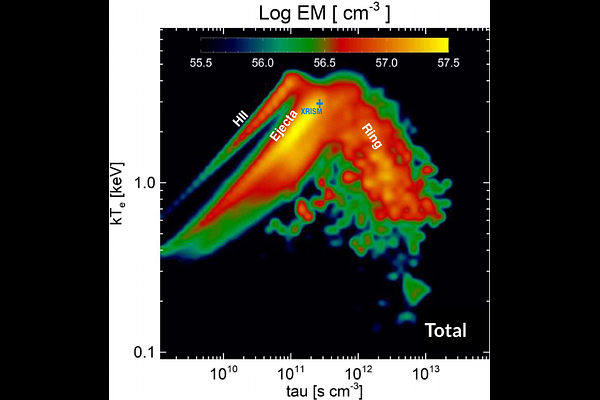Thermal and Kinematic Properties of Ejecta in SN1987A revealed by XRISM

Thermal and Kinematic Properties of Ejecta in SN1987A revealed by XRISM
XRISM collaboration
AbstractWe present an analysis of high-resolution spectra from the shock-heated plasmas in SN~1987A, based on an observation using the Resolve instrument onboard the X-Ray Imaging and Spectroscopy Mission (XRISM).The 1.7--10 keV Resolve spectra are accurately represented by a single component, plane-parallel shock plasma model, with a temperature of $2.84_{-0.08}^{+0.09}$ keV and an ionization parameter of $2.64_{-0.45}^{+0.58} \times 10^{11}$ s cm$^{-3}$.The Resolve spectra are also well reproduced by the 3-D magneto-hydrodynamic simulation presented by Orlando et al. (2020) suggesting substantial contribution from the ejecta.The metal abundances obtained with Resolve align with the LMC value, indicating that the X-rays in 2024 originate from non-metal-rich shock-heated ejecta and the reverse shock has not reached the inner metal-rich region of ejecta.Doppler widths of the atomic lines from Si, S, and Fe correspond to velocities of 1,500--1,700 km s$^{-1}$, where the thermal broadening effects in this non-metal-rich plasma are negligible. Therefore, the line broadening seen in Resolve spectra is determined by the large bulk motion of ejecta. For reference, we determined a 90\% upper limit on non-thermal emission from a pulsar wind nebula at $4.3 \times 10^{-13}$ erg cm$^{-2}$ s$^{-1}$ in the 2 -- 10 keV range, aligning with NuSTAR findings by Greco et al. (2022). Additionally, we searched for the $^{44}$Sc K line feature and found a $1\sigma$ upper limit of $1.0 \times 10^{-6}$ photons cm$^{-2}$ s$^{-1}$, which translates to an initial $^{44}$Ti mass of approximately $2 \times 10^{-4} M_{\odot}$, consistent with previous X-ray to soft gamma-ray observations (Boggs et al. 2015; Grebenev et al. 2012; Leising 2006).